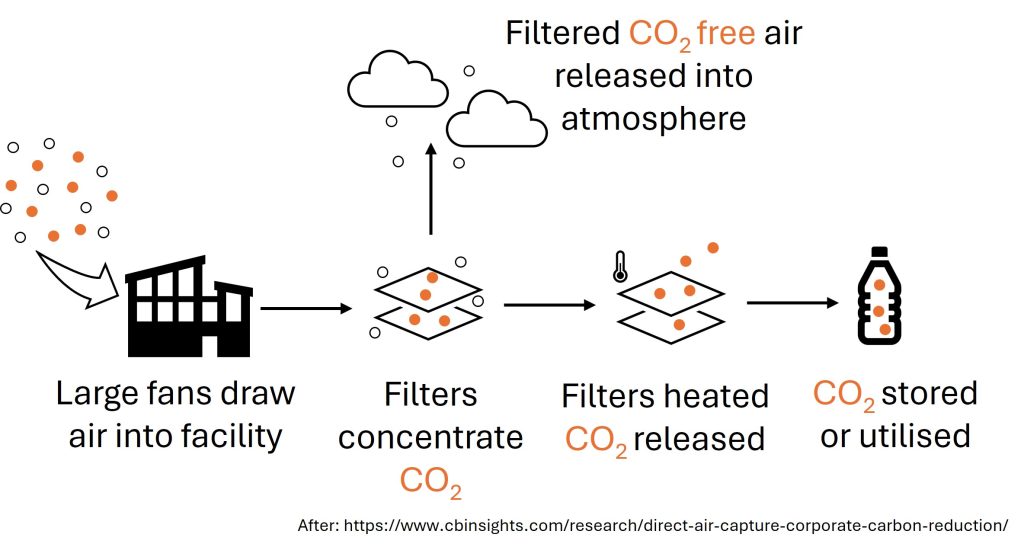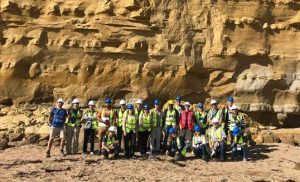In the pursuit of a sustainable future, Carbon Capture Utilisation and Storage (CCUS) has emerged as a powerful tool in curbing carbon emissions. Especially for those industries such as cement manufacturing and aluminium and steel production, where alternative solutions to their energy requirements have not yet been identified.
At the heart of CCUS lies the crucial first step: carbon capture. This process involves the extraction of carbon dioxide (CO2) from industrial processes before it is released into the atmosphere. In this blog, we will explore the various methodologies employed in this essential stage of the CCUS journey.
Post-Combustion Capture: A potential retrofit solution

Post-combustion capture is one of the most widely adopted methodologies in the realm of carbon capture. It involves the capture of CO2 from the flue gases produced by power plants or industrial facilities (Figure 1). Here is how it works:
1. Flue Gas Treatment: The flue gases, which contain a mixture of gases including CO2, are first treated to remove impurities such as sulphur dioxide (SO2) and nitrogen oxides (NOx).
2. Absorption Process: The treated flue gases are then exposed to a solvent or absorbent material that selectively traps the CO2. This creates a solution rich in CO2.
3. Regeneration: The CO2-rich solution is then processed to separate the CO2, allowing for its capture and storage.
Post-combustion capture is particularly advantageous as it can be retrofitted onto existing power plants and industrial facilities, making it a feasible option for emissions reduction.
Pre-Combustion Capture: Capturing Carbon at the Source

Pre-combustion capture is another powerful method for extracting CO2, especially in integrated gasification combined cycle (IGCC) power plants (Figure 2). Here is how it operates:
1. Gasification: Feedstocks, such as coal or biomass, are converted into a synthetic gas (syngas) through a process known as gasification.
2. CO2 Separation: The syngas is then subjected to a gas shift reaction to produce hydrogen (H2) and CO2. The CO2 can be readily separated from the H2.
3. Utilisation or Storage: The separated CO2 can either be utilised in various industrial applications or safely stored underground.
Pre-combustion capture is particularly advantageous in scenarios where feedstocks are used, allowing for the capture of CO2 before combustion occurs.
Advanced Carbon Capture Techniques: Beyond Post-Combustion and Pre-Combustion Methods

1. Oxy-Fuel Combustion Capture: In this process, fossil fuels are burned in an oxygen-rich environment, producing a flue gas primarily composed of CO2 and water vapor, which can be easily captured.
2. Direct Air Capture (DAC): DAC technology captures CO2 directly from the ambient air (Figure 3). It is a relatively new and emerging technology. The advantage of this method is that it does not need to be close to a CO2 source, but can instead be close to the storage site.
3. Carbon Mineralisation or Mineral Carbonation: This process involves converting CO2 into stable carbonates through chemical reactions with minerals. This can be done naturally in certain geological formations or in engineered systems.
4. Biological Carbon Capture: This approach uses biological processes, such as algae cultivation, to capture and convert CO2 into biomass.
5. Membrane-Based Carbon Capture: This technology uses specialised membranes to separate CO2 from other gases.
6. Adsorption-Based Carbon Capture: This method uses solid materials, known as adsorbents, to capture CO2 from flue gases.
7. Cryogenic Carbon Capture: This process involves cooling flue gases to very low temperatures, causing CO2 to condense and be separated from other gases.
Merlin Energy’s Expertise in Carbon Capture
CCUS, and its associated workflows, is not dissimilar to traditional oil and gas exploration, with its risk mapping, regional screening, and geological analysis. The hydrocarbon exploration community is therefore well placed to fill the emerging skills gap in the carbon sequestration market. Merlin have staff with experience in CCUS and the differences between this and traditional petroleum geology approaches, and are therefore well placed to support CCUS evaluations.
At Merlin Energy Resources Limited, we leverage our extensive knowledge in subsurface engineering to play a pivotal role in CCUS projects. From evaluating suitable storage sites to conducting risk assessments, our expertise extends across all stages of the carbon capture process.
As we continue our commitment to sustainable practices, we are dedicated to advancing CCUS technologies and contributing to a more environmentally responsible future.
Stay tuned for the next episode in our CCUS series, where we will delve into the utilisation of captured carbon and its wide-ranging applications.
For more information about Merlin Energy Resources Limited and our contributions to CCUS projects, visit our website.



